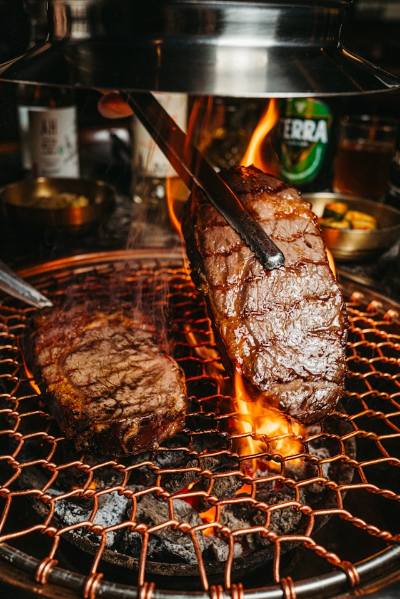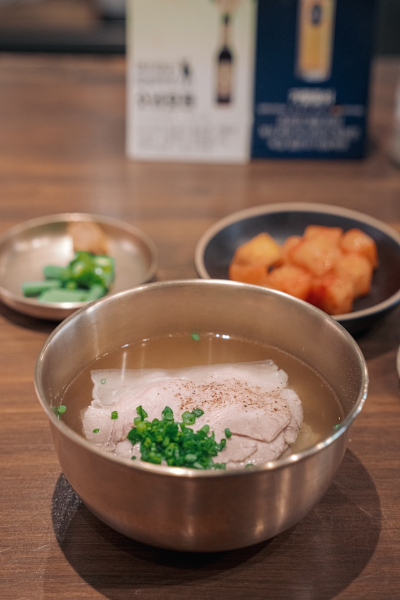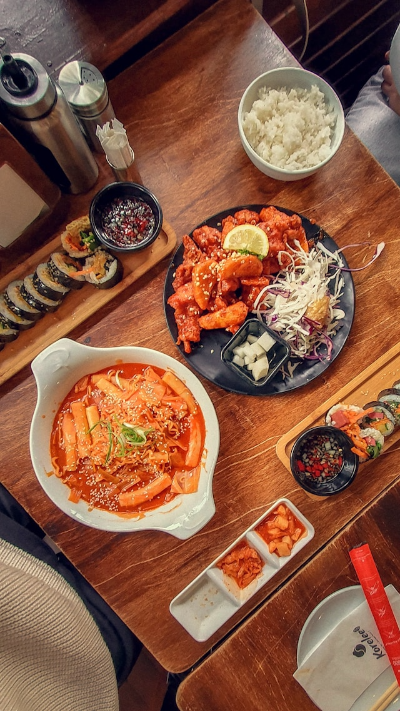상세 컨텐츠
본문
From silent cafés to solo BBQ survival, here's everything you need to know about eating out in Korea — the wins, the fails, and the delicious in-betweens.
Let me just say this: I thought I knew how to eat out.
I’ve dined alone in Paris cafés, eaten my way through Bangkok street food, even survived a raw goat dish in Kenya.
But nothing prepared me for ordering a simple meal in Korea. Nothing.
It started innocently enough. First week in Seoul. I was craving something warm. Comforting. Korean.
I walked into a local restaurant near my officetel. No English menu. No pictures. Just a woman behind the counter shouting something that sounded like “김치찌개 or nothing.”
I nodded. She nodded.
Ten minutes later, I had something red, bubbling, and suspiciously full of seafood.
I don't eat seafood.
That was my first Korean eating out fail. And believe me, it wasn’t the last.

🥢 How Eating Out in Korea Is *Not* Like Back Home
Here’s the thing about Korean dining culture:
It’s fast. Efficient. Social. And sometimes very, very quiet.
Let me explain.
Back home, eating out is an *event*. You chat with the server, maybe ask questions, linger a bit.
In Korea? You walk in, order quickly, eat faster, and leave before the next customer stares you out of your seat.
I once stayed too long in a BBQ place, just enjoying the atmosphere.
The owner turned off the lights at 9:30 pm — while I was still chewing.
Subtle. Respectfully aggressive.

🍖 The Glory of Korean BBQ (And the Tongs That Betrayed Me)
Okay, let’s talk about Korean BBQ — because *yes*, it really is that good.
The first time I tried it, I was with two local friends.
They handled everything: the grill, the meat, the lettuce wraps. I just smiled, nodded, and stuffed my face.
The second time? I went solo.
I confidently picked a place, sat down, ordered samgyeopsal like a pro.
The server brought the meat, the tongs, the scissors — then left.
I stared at the raw pork.
It stared back.
Turns out… I had to cook it. Myself.
And let’s just say, flipping greasy meat with tongs while sweat drips from your forehead and a table of ajummas watches in silent judgment is a rite of passage I didn’t expect.
📌 Related Posts You’ll Want to Reheat:
Day 5: Banking in Korea — The ATM Yelled at Me and Other Financial Misadventures
Because paying for your meal should be easier than decoding a bank app in Korean.
Day 6: Finding a Home in Korea — Deposits, Tiny Studios, and Paperwork Overload
Where you eat depends on where you live — and in Korea, both are an adventure.

🙃 When Silence Isn’t Golden: The Library Cafés of Seoul
So I went to a café in Hongdae one afternoon to do some writing.
It was beautiful — soft jazz, concrete walls, latte art so good it made me emotional.
I opened my laptop, plugged in my headphones, and called a friend.
Not even a minute into the call, the barista appeared like a silent ghost.
He didn't say a word — just placed a post-it on my table:
> “Please no loud talking. Thank you :)”
I looked around.
Every single person was wearing headphones. No one spoke. It was *a library with overpriced cake*.
🤯 Menu Roulette and the “Let’s Just Point” Strategy
One thing about eating out in Korea: menus are often in Korean. Sometimes there are pictures.
Sometimes those pictures lie.
Once I pointed at a dish that looked like beef stew.
What arrived was blood sausage in soup. With lung. And liver. And possibly something else I don’t want to name.
I’ve learned a few strategies since then:
- Use *Papago*, not Google Translate. Trust me.
- Look for “한글 + 사진” menus — Korean-only text but with photos.
- Or better yet, just say **“이거 주세요” (ee-geo ju-se-yo)** and point.
Works 80% of the time. The other 20%? Adventure.

🧂 The Side Dish Situation
Side dishes. Glorious, free, refillable *banchan*.
My first banchan shock came in a tiny family restaurant in Busan.
I ordered bibimbap. Then — without warning — the table exploded with food. Ten small plates: kimchi, radish, spinach, something brown, something spicy, something… moving?
I panicked. I thought I had *accidentally* ordered a full-course meal.
I asked the owner if this was a mistake.
She laughed. “서비스~!” she said. It means “free.” Magic words.
Now? I live for banchan

.
🤐 The Tipping Trap
Spoiler: *You don’t tip in Korea.* Ever.
But no one told me this early on.
I left ₩2,000 on the table once. The owner chased me down the street to return it.
I thought I was in trouble. She just smiled, bowed, and put the money back in my hand.
Lesson learned. Keep your cash in your wallet.
Appreciation in Korea isn’t money. It’s saying “맛있어요!” (It was delicious!).
🍜 What’s your most hilarious or awkward dining experience abroad?
Have you ever cooked your own meat at a restaurant or pointed at a menu and instantly regretted it?
Drop your story below — we’ll cry-laugh together. 😅
🌐 [Navigate Korean Restaurant Etiquette: A Guide for Foreigners]
> If you're still confused about what to say when entering a restaurant or whether you're supposed to grill your own meat, this guide breaks down Korean restaurant etiquette in a simple and friendly way — perfect for first-timers and shy solo diners.
📱 [How to Use Korean Food Delivery Apps: A Simple Guide for Foreigners]
> Prefer to eat in? This guide walks you through Korean delivery apps like Baemin and Coupang Eats, even if you don’t speak a word of Korean. Seriously, it saved me from starving more than once.
🥢 [A Guide to Korean Dining Etiquette – Foreigner Living in Korea]
> Wondering why no one touches their spoon first? Or why the server looks horrified when you pour your own soju? This etiquette guide gives you insider tips on Korean table manners that even some locals forget.
🚚 [How to Use Food Delivery Apps in Korea – A Guide for Foreigners]
> Too tired to cook or go out? This step-by-step guide shows exactly how to register, order, and pay using Korean food delivery apps — all in English and with screenshots.

😅 Dining Solo in Korea: You’re Not Weird
At first, I was self-conscious eating alone.
Every restaurant seemed full of groups. Shared dishes. Loud conversations.
I felt… out of place.
But then I found *혼밥 (honbap)* spots.
They’re made for solo diners — booth seating, quick service, perfect portions.
There’s something deeply comforting about eating donkatsu in peace while watching K-drama reruns on a built-in screen.
Pro tip: Any place with a partition between seats? Solo-friendly heaven.
🥘 What I Wish I Knew Before Eating Out
If I could talk to my past self, here’s what I’d say:
- Bring tissues — some places have no napkins.
- Water is self-serve. Always. Look for the jug.
- Food comes fast — don’t wander off after ordering.
- You cook your own food more often than you think.
- No one expects perfect Korean. Just smile and try.
🎮 Final Thoughts
Eating out in Korea is wild.
One day you’re grilling meat like a local, the next you’re accidentally ordering live octopus.
You’ll laugh, you’ll sweat, you’ll probably burn a pancake or two.
But that’s the fun of it.
And slowly — between the kimchi refills and the steamy jjigae bowls —
you’ll feel less like a tourist and more like someone who belongs here.
Even if the tongs still confuse you.
> 🍳 Tomorrow?
We talk "cooking at home in Korea" — where to buy ingredients, how tiny your kitchen will be, and the time I set off a smoke alarm making ramen.
*Spoiler: It wasn’t even spicy ramen.*
🍳 Up Next: Cooking at Home in Korea — Smoke Alarms, Tiny Kitchens, and Ramen Redemption
Living in Korea means learning how to survive with two burners, no oven, and a fridge that sings. Tomorrow, we cook. (Or try to.)
Even if the tongs still confuse you.




